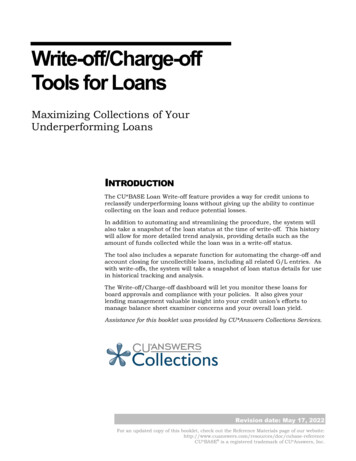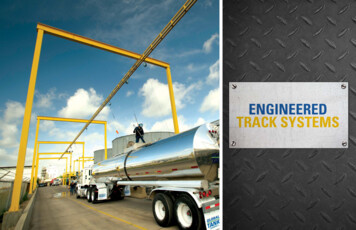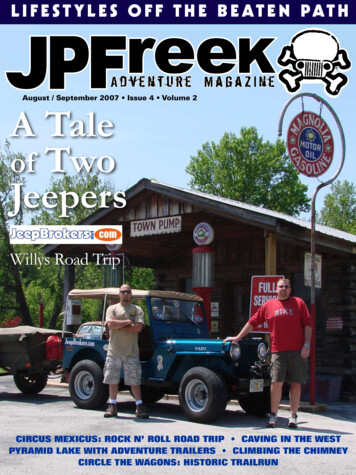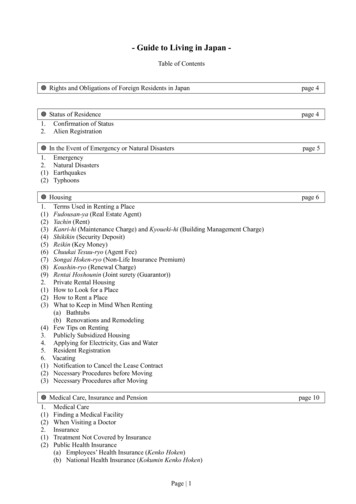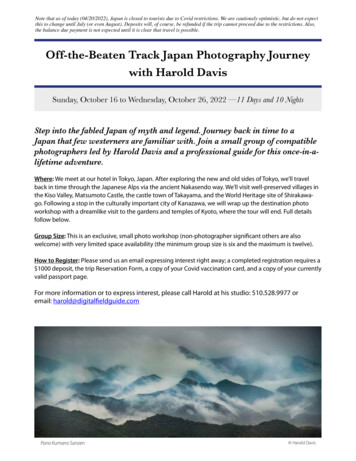
Transcription
Note that as of today (04/20/2022), Japan is closed to tourists due to Covid restrictions. We are cautiously optimistic, but do not expectthis to change until July (or even August). Deposits will, of course, be refunded if the trip cannot proceed due to the restrictions. Also,the balance due payment is not expected until it is clear that travel is possible.Off-the-Beaten Track Japan Photography Journeywith Harold DavisSunday, October 16 to Wednesday, October 26, 2022 —11 Days and 10 NightsStep into the fabled Japan of myth and legend. Journey back in time to aJapan that few westerners are familiar with. Join a small group of compatiblephotographers led by Harold Davis and a professional guide for this once-in-alifetime adventure.Where: We meet at our hotel in Tokyo, Japan. After exploring the new and old sides of Tokyo, we’ll travelback in time through the Japanese Alps via the ancient Nakasendo way. We’ll visit well-preserved villages inthe Kiso Valley, Matsumoto Castle, the castle town of Takayama, and the World Heritage site of Shirakawago. Following a stop in the culturally important city of Kanazawa, we will wrap up the destination photoworkshop with a dreamlike visit to the gardens and temples of Kyoto, where the tour will end. Full detailsfollow below.Group Size: This is an exclusive, small photo workshop (non-photographer significant others are alsowelcome) with very limited space availability (the minimum group size is six and the maximum is twelve).How to Register: Please send us an email expressing interest right away; a completed registration requires a 1000 deposit, the trip Reservation Form, a copy of your Covid vaccination card, and a copy of your currentlyvalid passport page.For more information or to express interest, please call Harold at his studio: 510.528.9977 oremail: harold@digitalfieldguide.comPano Kumano Sanzen Harold Davis
Journey DetailsWelcome to a photographic journey that not only presents a visual journey of Japan, but also a deep diveinto its history from the pulsing present-day capital of Tokyo, back into rural areas in the central mountainsalong paths where shoguns and samurai once tread, and then on the to the ancient capital of Kyoto, Japan’sspiritual, political, and cultural center for 1400 years.After discovering the new and old sides of modern Tokyo, we will jump back 400 years and from Tokyo Bayto the Japanese Alps. In feudal times people travelling from Kyoto to Tokyo would use the Nakasendo wayñ the road through the central mountains ñ one of a network of ancient highways. We will visit one of thebest-preserved sections in the Kiso Valley, where the lovely villages of Tsumago and Magome have been immaculately restored.In the Hida region, we will visit the castle town of Takayama, isolated by a barricade of mountains. Thesuperb local crafts and architecture are much in evidence in the old town, with the preserved merchantsíhouses, tea houses, local sake, and crafts shops specializing in lacquerware, pottery, and furniture. Further north is Shirakawa-go, a UNESCO World Heritage site since 1995, where will discover the traditionallythatched gassho-zukkuri houses. These large wooden houses have steep thatched roofs, designed to withstand heavy snow, and the term gassho-zukkuri refers to the shape of praying hands formed by the roofs.Dawn in the High Fields Harold Davis– –
From the mountains, we will move to Kanazawa, a city that retains many traces of its important politicalpast. Here we will discover old geisha teahouse districts, one of Japanís most famous gardens, a lively market, and a strong cultural heritage.From Kanazawa, we will travel to Kyoto, Japanís capital for more than a thousand years. The city is home tomore than 1600 Buddhist temples, hundreds of Shinto shrines, imperial palaces and formal gardens. Therewill be ample time to explore this historical city, and also enjoy some of the wonderful Kyoto cuisine, with itsrefined preparation and artistic presentation.Acclaimed photographer and bestselling photography book author Harold Davis will help guide this tripand share his love for photographing Japan throughout the tour. The tour will include guided photographysessions, tips about technique, informal discussions of photography goals and style, optional assignments,and one-on-one availability with Harold.Fitness Level: Moderate; to fully enjoy Off-the-Beaten Track Japan Photography Journey with Harold Davis,you should be able to comfortably walk a moderate distance (two or three miles) at a leisurely pace whilecarrying a backpack with a camera and a few items such as a water bottle and a raincoat.Buddha Samadhi Harold Davis– –
Assisting with Air Travel Arrangements: We’re happy to consult and advise regarding air travel arrangements to Tokyo on request. Directions for transferring from Narita Airport to our meeting-point hotel will beprovided.Cost: 8,995 per person (single supplement 1,320 as explained below); 500 early-bird discount for completed registration by January 30, 2021.Single supplement: The single supplement covers single rooms in Tokyo, Matsumoto, Kanazawa, and Kyoto.Outside these cities, please understand that single rooms may not be available in ryokans, which are smaller,traditional accommodations. We will be traveling Japanese-style, where group members of the same sexmay be paired, particularly in smaller country inns.Our in-bound travel partner is Oku Japan.Day1Day1232344ActivityArriveActivityTokyo and meet at your tour hotel; TourorientationDinnerArrive TokyoandandWelcomemeet at yourtour hotel; TourSightseeingin Tokyoorientation andWelcome DinnerPosttowns ofSightseeingin MagomeTokyo to Tsumago, optional 3 hourwalkon theofNakasendoPost townsMagome to Tsumago, optional 3 hourwalkon theNakasendoMorningshootingin Tsumago, 1 hour walk to Nagiso,Trainto ingin Tsumago,1 hourwalk to Nagiso,FukushimaTrain to Kiso Fukushima, afternoon sightseeing KisoFukushimaTrainto Narai, sightseeing in Narai, 1 hour walk fromNaraito Narai,Kiso Hirasawa,trainMatsumotoTrain tosightseeingin toNarai,1 hour walk fromNarai to KisoHirasawa,to MatsumotoMorningsightseeingandtrainshootingin Matsumoto,highwayto TakayamaMorning bussightseeingand shooting in Matsumoto,highway busandto TakayamaSightseeingshooting in TakayamaSightseeing and shooting in TakayamaExcursion to Shirakawago en route to KanazawaExcursionto ShirakawagoTrainto Kyoto,sightseeingenin routeKyototo KanazawaSightseeingand sightseeingshooting in Kyoto,Farewell DinnerTrain to Kyoto,in KyotoOvernightTokyo(hotel)OvernightTokyo (hotel)Tokyo (hotel)Tokyo (hotel)Tsumago(minshuku – smalltraditionalinn )Tsumago (minshuku– smalltraditionalinn ) (onsen ryokan –KisoFukushimaJapanesehot springsinn)Kiso Fukushima(onsenryokan –Japanese hot springs inn)MatsumotoMatsumotoTakayama (ryokan – traditionalJapaneseTakayamainn)(ryokan – traditionalJapanese inn)Takayama(ryokan – traditionalJapaneseTakayamainn)(ryokan – traditionalJapanese oKyoto (hotel)(hotel)MealsDMealsDBBB, DB, DB, DB, D5B5B6B, D6B, D7B, D7B, D8B89B910B,B D11Endof tour and shooting in Kyoto, Farewell Dinner10SightseeingKyoto (hotel)B, DB11End of tourIncluded in the tour cost AccommodationIncludedin the tour cost in hotels, Japanese-style inns (ryokan, minshuku)accommodationwill generallyin tatami-matrooms Japanese-styleAccommodationin hotels, Japanese-styleinnsbe(ryokan,minshuku) Mealsare includedas marked atwillthegenerallybottom ofday’s itineraryand in the table aboveJapanese-styleaccommodationbeeachin tatami-matrooms Alltransportationtouris included.This willnormallyby trainMealsare includedbetweenas markedatlocationsthe bottomof each day’sitineraryand bein thetable(bulletabove trains and local), bussometimes taxi andAll transportationbetween tour locations is included. This will normally be by train (bullet trains and local), bus Full-timeservicesof a tour leaderand sometimestaxi Entranceto museums,temples,Full-time servicesof a tourleaderetc. as indicated in the itinerary Luggageas detailedbelowEntrancetransferto museums,temples,etc. as indicated in the itinerary Freeof chargeplacefor HaroldDavisLuggagetransferas detailedbelow Free of charge place for Harold DavisNot included in the tour cost FlightsfromNot includedin totheandtourcostJapan AirporttransfersFlights toand from Japan Mealslisted as includedAirportnottransfersDrinks not(suchas wineand beer),snacks and miscellaneousitems Drinkswithlistedmeals,and miscellaneousitemsMealsas snacksincluded Entrancefeesto museums,templesetc. not includedDrinks withmeals,snacks andmiscellaneousitems on the itinerary Entrance fees to museums, temples etc. not included on the itineraryAccommodation notes– –Thefollowing typesof accommodation are used on this tour:AccommodationnotesThe following types of accommodation are used on this tour:Hotel (Tokyo, Matsumoto, Kanazawa, Kyoto)Modernwestern-stylehotelsare used inTokyo, Kanazawa, and Kyoto. The rooms are generally smaller than equivalentHotel (Tokyo,Matsumoto,Kanazawa,Kyoto)
Flights to and from JapanAirport transfersMeals not listed as includedDrinks with meals, snacks and miscellaneous itemsEntrance fees to museums, temples etc. not included on the itineraryAccommodation notesThe following types of accommodation are used on this tour:Hotel (Tokyo, Matsumoto, Kanazawa, Kyoto)Modern western-style hotels are used in Tokyo, Kanazawa, and Kyoto. The rooms are generally smaller than equivalenthotels in the West. All have en-suite facilities, air-conditioning, TV and fridges in roomsRyokan (Takayama, Kiso Fukushima)Ryokan are traditional Japanese-style inns. They may be in modern concrete or older wooden buildings but the roomsare always in the Japanese style with tatami (straw) matting and futons laid out in the evening by the ryokan staff.Evening meals are served together usually in the dining room, and are exquisitely prepared multi-course meals. Manyryokan have both en suite bathrooms (with the exception of some older buildings) and communal hot spring style baths(segregated by sex). They are the classic Japanese experience.Minshuku (Tsumago or O-Tsumago)Minshuku are usually family-run traditional Japanese-style inns. They have tatami-mat rooms, with futons laid out inthe evening for sleeping. Most minshuku do not have en suite bathrooms as they are in older traditional woodenOkuJapanKK, KyoeitheyChuoareBldgusually5F, 762 (butNishihashizumecho,Shimyogoku,Kyoto 600-8029buildings. Comparedwitha ryokan,not always) slightlyless formal,but theJAPANservice and food is justUK contact: 0207 099 6147 www.okujapan.comas good.Registered in the UK no. 5463494 Registered office: Lynton House, 7-12 Tavistock Square, London WC1H 9BQSingle roomsWe offer the option of a single room in Tokyo, Matsumoto, Kanazawa, and Kyoto. Single rooms may not be available inryokan and we may pair up members of your group of the same sex. In Japan ryokan rooms are less intimate spacesand we will travel the way the Japanese do.MealsMost meals will be Japanese cuisine. Vegetarian options are available, but limited. Alcoholic drinks are not included.Tips are not required in Japan.Baggage handlingLuggage will be sent ahead by courier on four occasions (Tokyo on Day 3 to Kiso Fukushima on Day 4, Kiso Fukushimaon Day 5 to Takayama on Day 6, Takayama on Day 8 to Kyoto on Day 9. You will be without your main luggage for onenight on each occasion, so please prepare an overnight bag or daypack to carry your overnight items.Clothing and equipmentYukata (simple cotton kimono) are provided at each ryokan or minshuku, and you can wear this during your stayin the Japanese style accommodation both indoors and outdoors. Yukata and slippers provided by regular hotelsare normally only used in the private rooms. This will allow you to pack lightly for the walking sections. Soap andshampoo are always available at any accommodations.EquipmentHairdryers are provided in the regular hotels and in the public bathrooms in Ryokan. They are usually available insome minshuku, too.For autumn tours: long sleeves are recommended during the Nakasendo walking, but you should not need heavysweaters. You should have a light windbreaker or a rain jacket, and bringing a selection of light layers to wear willbe most helpful.If bringing any appliance please note that most North American appliances can be used in Japan. Please ensureyour appliance has a plug with 2 flat prongs. Outlets in Japan do not accept 3 prong grounded plug types. Some ofthe minshuku may only have a limited number of outlets in the room so if you are charging more than one item ofequipment, you may wish to bring a small multi socket charger.– –One bag will be shipped ahead daily for pickup at the next hotel except on Day 3 and 4 and Day 8. Limit yourself toone duffle or soft-sided suitcase for your hiking gear so that the baggage transfer can be done efficiently. You will Harold DavisBathing suits cannot be used in the public bathrooms.
buildings. Compared with a ryokan, they are usually (but not always) slightly less formal, but the service and food is justas good.Single roomsWe offer the option of a single room in Tokyo, Matsumoto, Kanazawa, and Kyoto. Single rooms may not be available inSingle roomsryokan and we may pair up members of your group of the same sex. In Japan ryokan rooms are less intimate spacesWe offer the option of a single room in Tokyo, Matsumoto, Kanazawa, and Kyoto. Single rooms may not be available inand we will travel the way the Japanese do.ryokan and we may pair up members of your group of the same sex. In Japan ryokan rooms are less intimate spacesand we will travel the way the Japanese do.MealsMost meals will be Japanese cuisine. Vegetarian options are available, but limited. Alcoholic drinks are not included.MealsTips are not required in Japan.Most meals will be Japanese cuisine. Vegetarian options are available, but limited. Alcoholic drinks are not included.Tips are not required in Japan.Baggage handlingLuggage will be sent ahead by courier on four occasions (Tokyo on Day 3 to Kiso Fukushima on Day 4, Kiso FukushimaBaggage handlingon Day 5 to Takayama on Day 6, Takayama on Day 8 to Kyoto on Day 9.). You will be without your main luggage for oneLuggage will be sent ahead by courier on four occasions (Tokyo on Day 3 to Kiso Fukushima on Day 4, Kiso Fukushimanight on each occasion, so please prepare an overnight bag or daypack to carry your overnight items. A small backpackon Day 5 to Takayama on Day 6, Takayama on Day 8 to Kyoto on Day 9. You will be without your main luggage for onethatused to carrycameragear isanbestfor thesebagovernights.nightcanonalsoeachbeoccasion,so pleaseprepareovernightor daypack to carry your overnight items.Clothing and equipmentYukata(simplecotton kimono) are provided at each ryokan or minshuku, and you can wear this during your stayClothingand equipmentintheJapanesestyle accommodationboth indoorsoutdoors.Yukata andregularhotelsYukata (simple cottonkimono) are providedat eachandryokanor minshuku,and slippersyou can providedwear ections.Soapandin the Japanese style accommodation both indoors and outdoors. Yukata and slippers provided by regular hotelsshampooare onlyalwaysavailableat any accommodations.are normallyusedin the privaterooms. This will allow you to pack lightly for the walking sections. Soap andshampoo are always available at any accommodations.EquipmentHairdryersEquipmentare provided in the regular hotels and in the public bathrooms in Ryokan. They are usually available insomeminshuku,too. in the regular hotels and in the public bathrooms in Ryokan. They are usually available inHairdryersare providedsome minshuku, too.Bathing suits cannot be used in the public bathrooms.Bathing suits cannot be used in the public bathrooms.For autumn tours: long sleeves are recommended during the Nakasendo walking, but you should not need heavysweaters.Youshouldhavea lightor aduringrain jacket,and bringinga selectionof lightlayerswearwillFor e Nakasendowalking,but youshouldnot toneedheavybemost helpful.sweaters.You should have a light windbreaker or a rain jacket, and bringing a selection of light layers to wear willbe most helpful.If bringing any appliance please note that most North American appliances can be used in Japan. Please ensureyourappliancehas a plugpleasewith 2 noteflat prongs.OutletsJapan do appliancesnot accept can3 pronggroundedplugPleasetypes.ensureSome ofIf bringingany appliancethat mostNorthinAmericanbe usedin sintheroomsoifyouarechargingmorethanoneitem ofyour appliance has a plug with 2 flat prongs. Outlets in Japan do not accept 3 prong grounded plug types. Someofequipment,youmaywishto bringa smallmultiofsocketcharger.the minshukumayonlyhavea limitednumberoutletsin the room so if you are charging more than one item ofequipment, you may wish to bring a small multi socket charger.One bag will be shipped ahead daily for pickup at the next hotel except on Day 3 and 4 and Day 8. Limit yourself tooneor besoft-sidedfor yourhiking atgearthathotelthe baggagetransfercan 4beanddoneYou willtoOnedufflebag willshippedsuitcaseahead dailyfor pickupthesonextexcept onDay 3 andDayefficiently.8. Limit yourselfbefor the costof additionalno portersfor thistrip, socanyoubewillcarryyour ownYou willoneresponsibleduffle or soft-sidedsuitcasefor yourbags.hikingTheregear areso thatthe elsonlywherethisownservice isbe responsible for the cost of additional bags. There are no porters for this trip, so you will carry ��35lbs.attimeofdeparture.Thetotaldimensionsof theisbaggage on/off the trains from and to the airport. Porterage may be provided at hotels only where this vailable. Your suitcase should weigh no more than 30–35 lbs. at time of departure. The total dimensions of the apieceof soft-sidedmeasured25 width,x 18 x 14totalof 25 18 1457 example,inches andabag whenyou add luggagethe bedimensionsno more than62 inches.or(Forbewithinthese sizeluggagelimits). that measured 25 x 18 x 14 would have total dimensions of 25 18 14 or 57 inches andpieceof soft-sidedbe within these size limits).On the hikes, guests will need to carry a daypack large enough to hold their water bottle, camera and equipment,raingearand anythingelsethey’llneedaforthe day,andenoughany extraitemstheirsuchwateras a changeof clothesandovernightOn thehikes,guests willneedto carrydaypacklargeto holdbottle, on’tforgetrain gear and anything else they’ll need for the day, and any extra items such as a change of clothes and overnightothersuch as onnecessarymedications.items essentialsfor the overnightDay 3 and4 and Day 8, when guests will not have access to their luggage. Don’t forgetOku Japan KK, Kyoei Chuo Bldg 5F, 762 Nishihashizumecho, Shimyogoku, Kyoto 600-8029 JAPANUK contact: 0207 099 6147 www.okujapan.comOku JapanChuo Bldg5F, isteredin theKK,UK Kyoeino. 5463494RegisteredLynton House, 7-12TavistockKyotoSquare,London JAPANWC1H 9BQUK contact: 0207 099 6147 www.okujapan.comRegistered in the UK no. 5463494 Registered office: Lynton House, 7-12 Tavistock Square, London WC1H 9BQ– – Harold Davisother essentials such as necessary medications.
EquipmentHairdryers are provided in the regular hotels and in the public bathrooms in Ryokan. They are usually available insome minshuku, too.Bathing suits cannot be used in the public bathrooms.For autumn tours: long sleeves are recommended during the Nakasendo walking, but you should not need heavysweaters. You should have a light windbreaker or a rain jacket, and bringing a selection of light layers to wear willbe most helpful.If bringing any appliance please note that most North American appliances can be used in Japan. Please ensureyour appliance has a plug with 2 flat prongs. Outlets in Japan do not accept 3 prong grounded plug types. Some ofthe minshuku may only have a limited number of outlets in the room so if you are charging more than one item ofequipment, you may wish to bring a small multi socket charger.One bag will be shipped ahead daily for pickup at the next hotel except on Day 3 and 4 and Day 8. Limit yourself toone duffle or soft-sided suitcase for your hiking gear so that the baggage transfer can be done efficiently. You willbe responsible for the cost of additional bags. There are no porters for this trip, so you will carry your ownbaggage on/off the trains from and to the airport. Porterage may be provided at hotels only where this service isavailable. Your suitcase should weigh no more than 30–35 lbs. at time of departure. The total dimensions of thebag when you add the bag’s external length, width, and height should be no more than 62 inches. (For example, apiece of soft-sided luggage that measured 25 x 18 x 14 would have total dimensions of 25 18 14 or 57 inches andbe within these size limits).On the hikes, guests will need to carry a daypack large enough to hold their water bottle, camera and equipment,rain gear and anything else they’ll need for the day, and any extra items such as a change of clothes and overnightitems for the overnight on Day 3 and 4 and Day 8, when guests will not have access to their luggage. Don’t forgetother essentials such as necessary medications. Harold DavisOku Japan KK, Kyoei Chuo Bldg 5F, 762 Nishihashizumecho, Shimyogoku, Kyoto 600-8029 JAPANUK contact: 0207 099 6147 www.okujapan.comRegistered in the UK no. 5463494 Registered office: Lynton House, 7-12 Tavistock Square, London WC1H 9BQ– –
Day-by-day itineraryDay 1 – Arrive in Tokyo, Tour Orientation, Welcome DinnerMeals: DinnerAccommodation: Park Hotel or similar (Tokyo tower roomssubject to availability) Harold DavisWelcome to Tokyo! Make your way to your tour hotelfrom the airport or your pre-tour travels and meet yourguide and the other members of your group in the lobby ofyour tour hotel at approximately 7pm. Then, we enjoydinner at a local restaurant, and a tour orientation overdinner as you get to know the other members of yourgroup and tour leader Harold Davis.This morning we walk from our hotel to the Hama-Rikyugardens, located near the mouth of the Sumida-gawa, alarge river flowing through Tokyo. The garden is dividedinto two major sections. The southern garden was the siteof a villa where the Shogun could relax, enjoy duck huntingand entertain visitors, including feudal lords, during the17th to 19th centuries. It contains the Shio-iri-no Niwa(garden with a tidal pond) which is on the sea, and thus itsscenery varies with the ebb and flow of the tide. There is astriking contrast between the gardens and the gleamingtowers of the new Shiodome business area beyond.From Hama-Rikyu garden, we will sail up the Sumida river to Asakusa. Asakusa is an old quarter in Tokyo’sshitamachi (‘low city’) which still displays some narrow streets reminiscent of Edo period Tokyo. Its mainattraction is Senso-ji, a large Buddhist temple with a five-story pagoda, dating originally from the 7th centuryand rebuilt after its destruction during World War II. With Asakusa Shrine nearby, the complex serves as thesite for several religious festivals throughout the year. Leading up to the main temple buildings is theNakamise-dori, a pedestrian street lined with shops selling a variety of Japanese arts and crafts, traditionalsnacks and souvenirs. At the end of the street is the Kaminarimon, the famous entrance gate to the temple.We pause in Asakusa for lunch, and then continue on by subway to discover modern Tokyo. We begin with avisit to Meiji Jingu Shrine. The grand Meiji Shrine was built in the early 20th century as a memorial to EmperorMeiji (reigned 1868-1912) and his consort, Empress Shoken. The shrine is located in a large wooded park whichyou enter through the southern gate, near Harajuku station. Many Shinto ceremonies are held in the mainbuilding of Meiji Shrine and you may spot a wedding procession going by. Emperor Meiji is credited withopening Japan to the modern age. Just yards away from this quite setting, we continue on to see famousHarajuku - Tokyo’s district known for its avant-garde street fashion, centering in Takeshita-dori, its mainshopping street, lined with boutiques and cafes. From here, we walk along to the famous Shibuya Scrambleand enjoy the pulse of urban Japan. The Shibuya area is a great location for blue-hour shooting of the lightsand hum of the city. Tonight dinner is on your own so you can shoot to your heart’s content in Shibuya. Thereare a large number of options in the area, and in particular in the many buildings around Shibuya that containshops and restaurants.Meals: BreakfastAccommodation: Park Hotel or similar (Tokyo tower rooms subject to availability)– –Oku Japan KK, Kyoei Chuo Bldg 5F, 762 Nishihashizumecho, Shimyogoku, Kyoto 600-8029 JAPANVia Oku JapanDay 2 – Sightseeing in Tokyo: Traditional Tokyo morning, Modern Tokyo afternoon
NOTES: Today is best suited for hand-held shooting. Tripod shooting is not permitted at Hama-Rikyu Gardensor Senso-ji temple. The Asakusa area can be crowded on the main streets but the back streets can besomewhat quieter which would also make tripod shooting very difficult. In the morning, subject to weather, itmay be possible to shoot Tokyo Tower from Hama Rikyu Gardens as the sun is typically on the tower ratherthan coming from behind it.Today we travel by one of Japan’s famed bullet train toNagoya, and we connect to a limited express train toNakatsugawa, where we begin our exploration of theNakasendo Trail. This morning, we will send our mainluggage ahead of us overnight to meet us again on day 4 atour accommodation in Kiso Fukushima. Please bring withyou the equipment you would like to use to shoot todayand your overnight essentials. We recommend a backpackstyle bag for your essential items.Magome is a picturesque post town on the Nakasendo Trail,and the main street of the town winds its way up the side of the mountain. On each side are traditional Edoperiod inns. Small canals of water run along parts of the street, and waterwheels lazily make their turn.Magome is home to woodcrafters, as is the case in many of the post towns of the Nakasendo. The Kiso Valleyarea where we travel has longstanding traditions of wood working.Via Oku JapanDay 3 – Travel by Bullet train and Limited Express Train into the countryside, Visit Magome andTsumago, Optional hike on the Nakasendo TrailWe then have the option of hiking with the guide over the Magome pass to the Tsumago area. The hike isbeautiful, winding its way through hamlets and past small houses and shrines. From Magome pass the traildescends to Tsumago, passing waterfalls, stands of bamboo, and even old sections of ishidatami –cobblestones along the trail. We walk to the small and peaceful hamlet of O-Tsumago and stay either in OTsumago or Tsumago area.We spend the night at a family-run Minshuku in Tsumago, with a delicious home-cooked Japanese dinner andbreakfast included. After dinner, enjoy a stroll through the village streets in the magical quiet of the evening,wearing the yukata gown supplied by your inn.NOTES: Today, handheld shooting is of course possible. You may find it handy to have a lightweight collapsibletripod for shots of the town. The streets, particularly in Magome, which is on a steep incline, can be uneven.Within the post towns of Magome and Tsumago there are woodturners and craftspeople working in wood.With a polite request, they may be happy to allow you to take a photo of them at work. Early morning andearly evening are great times to take photos, and in the autumn, sunset will be quite early – at or before 5pm.Your guide will assist you with timings, but please be aware that at the small family run inns on the trail,breakfast and dinner are typically served at set times. We are happy to ask if the inn may slightly delay dinnerfor your group so you can take best advantage of the twilight.Walking distance: 8.3km / 5.2 milesElevation gain: 326m / 1,069 feet of ascent and 430m / 1,410 feet of descentTime required: About 3 hoursAccommodation: Minshuku (Family-run Guesthouse)Meals: Breakfast, Dinner– –Oku Japan KK, Kyoei Chuo Bldg 5F, 762 Nishihashizumecho, Shimyogoku, Kyoto 600-8029 JAPANUK contact: 0207 099 6147 www.okujapan.com
This morning, we enjoy a traditional Japanese breakfast and havesome time to shoot in Tsumago before day-trippers arrive. Wethen walk along a short and relatively flat 1 hour route to Nagisowhere we board the train in mid-morning to Kiso-Fukushima. Wewill enjoy some free time for lunch. A favourite are soba noodles,a traditional mountain specialty, but there is also a supermarketwith sandwiches available for those who wish to ‘grab and go’.Travel along the Nakasendo was very strictly controlled duringthe Edo period, and Kiso Fukushima is the location of one of thefour major checkpoints on the trail. The town also contains the historic Uenodan district which sits on ahillside above the Kiso River, and features a number of Edo period buildings. We will stroll the picturesqueareas of the town and along the Kiso River for a few hours before arriving at our hot spring ryokan in KisoFukushima. This evening, we are reunited with our main bags at our accommodation in Kiso Fukushima.Via Oku JapanDay 4 – Morning shooting in Tsumago, 1 hour walk to Nagiso, Train to Kiso Fukushima, afternoonsi
Off-the-Beaten Track Japan Photography Journey with Harold Davis Step into the fabled Japan of myth and legend. Journey back in time to a Japan that few westerners are familiar with. Join a small group of compatible photographers led by Harold Davis and a professional guide for this once-in-a-lifetime adventure.



